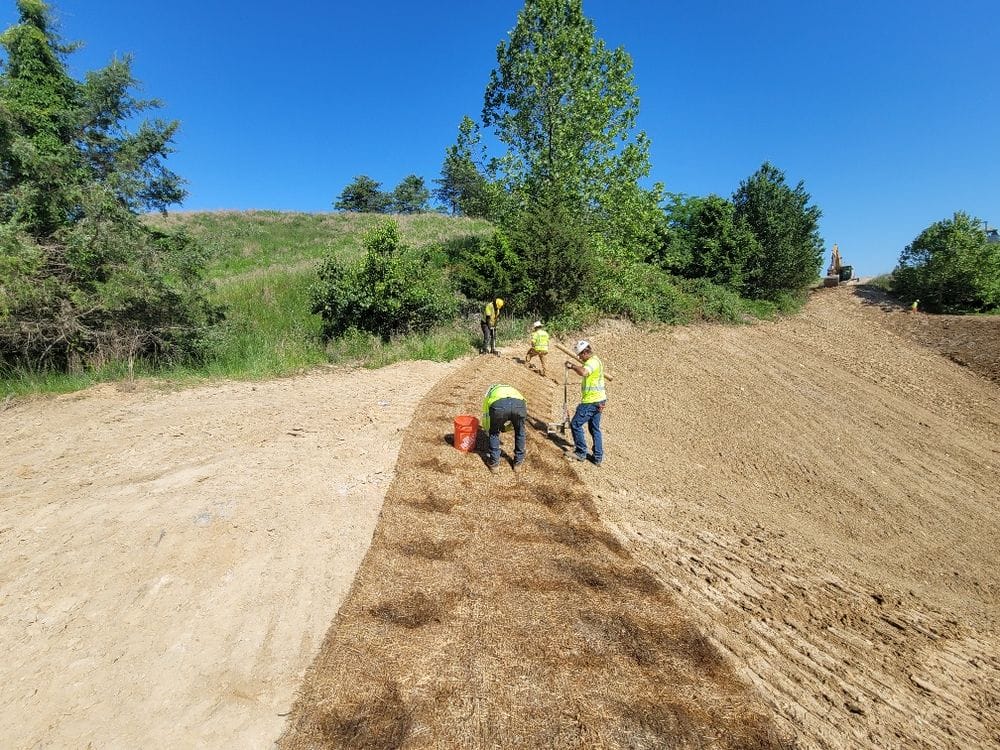Specialist Solutions by Memphis Erosion Control Solutions excavation
Wiki Article
Ideal Practices for Disintegration Control in Construction Projects
Are you dealing with a building and construction project and worried regarding erosion control? Look no more! In this write-up, we will direct you with the very best techniques for avoiding erosion on your website. You'll discover five necessary strategies, efficient sediment and overflow management approaches, essential considerations for incline stabilization, and ideas for shielding greenery and soil. We'll additionally look into the relevance of implementing appropriate drainage systems. Prepare yourself to tackle disintegration head-on and make certain the success of your building and construction task.5 Important Disintegration Control Techniques
To efficiently manage disintegration on your building website, you'll need to apply necessary techniques such as incline stablizing and sediment control procedures. Slope stablizing is essential in protecting against dirt disintegration on high slopes. Another efficient strategy is the usage of disintegration control blankets or mats, which are put on the slope and help keep soil particles while allowing vegetation to grow.
Effective Debris and Drainage Monitoring

You can successfully take care of debris and drainage in your building and construction task by applying proper disintegration control procedures. An additional vital practice is the application of disintegration control blankets or floor coverings. By applying these disintegration control measures, you can efficiently manage sediment and overflow in your construction project, minimizing the effect on the setting and abiding with regulative needs.
Trick Factors To Consider for Slope Stabilization
When taking into consideration slope stablizing, it is very important to assess the surface and identify prospective locations of instability. You need to very carefully examine the slope's characteristics, such as its make-up, drainage, and angle patterns. Search for indications of disintegration, such as exposed roots, fractures, or slumping soil. These indications can give you a concept of where stabilization procedures may be essential.When you have identified the unpredictable locations, you can start carrying out steps to maintain the slope. One usual method is the use of retaining walls or terracing to produce a series of level actions, which can help distribute the weight and stop more disintegration. Another option is to grow vegetation on the incline, as the roots can aid anchor the soil and control disintegration. Additionally, setting up erosion control coverings or mats can offer immediate security while plant life comes to be well-known.
It's vital to consistently keep track of the maintained inclines to ensure their performance. Watch anchor out for any indicators of motion or erosion, and take prompt activity if needed. Regular maintenance, such as checking and repairing any kind of damaged procedures, is also necessary to make certain lasting security.
Best Practices for Plants and Soil Protection
One effective means to secure plants and dirt on inclines is by on a regular basis examining for signs of erosion and taking prompt activity if necessary. Begin by inspecting the slope for any signs of disintegration, such as revealed origins, bare soil patches, or debris accumulation at the bottom. Implement erosion control procedures such as setting up disintegration control coverings, mulching, or even creating keeping wall surfaces if required.Executing Proper Drain Equipments
To effectively implement correct water drainage systems, it's essential to take into consideration the incline gradient and soil kind. When it concerns taking care of water circulation and avoiding erosion, understanding these aspects is vital. The slope gradient plays a significant duty in establishing just how water crosses the land. Steeper inclines can bring about faster water flow, boosting the danger of disintegration and flooding. On the other hand, gentler slopes enable water to stream more slowly, lowering disintegration potential. By assessing the incline gradient, you can design an effective water drainage system that accommodates the natural water movement.Soil type also affects drain system style. Different soil kinds have differing levels of permeability, influencing exactly how water is absorbed and drained pipes. For circumstances, sandy Check This Out dirts have a tendency to drain pipes faster due to their coarse structure, while clay soils have a slower water learn the facts here now drainage price due to their compact nature. Comprehending the soil kind assists in choosing suitable drainage strategies, such as utilizing permeable materials or installing French drains pipes. Additionally, considering the soil features assists prevent waterlogging, which can lead to poor plant growth and damage to structures.
Verdict
In verdict, when it comes to erosion control in construction projects, you have to adhere to these finest practices. Think about slope stablizing methods to guarantee the security of the website. By adhering to these essential practices, you can efficiently control erosion and make sure the success of your building and construction task.To effectively control disintegration on your construction site, you'll need to execute vital strategies such as incline stablizing and sediment control measures. Slope stabilization is vital in preventing soil erosion on steep slopes. One more efficient strategy is the use of erosion control coverings or floor coverings, which are placed on the slope and help preserve dirt particles while permitting plant life to grow. Another alternative is to grow vegetation on the incline, as the origins can help secure the soil and control erosion. Implement disintegration control procedures such as setting up erosion control blankets, mulching, or also creating maintaining walls if required.
Report this wiki page